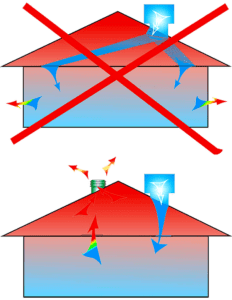Air Conditioning / Summer Cooling
Retail sales talk about air conditioning efficiency and touting their product to be the most efficient regarding energy consumption.
And there’s no doubt that there are energy efficient units in the marketplace.
The problem is that the air conditioning units are used in are less than ideal to allow for efficient return on cost.
One analogy being, keeping tyre pressure up while you have a hole in the tyre.
It’s not about volume loss but more about how the air volume is introduced into any given area.
Whatever system you use physical laws are involved and the best example of physics governing hot and cold is a hot water storage unit.
Laws of physics are the same for air and water.
The cold water comes in at the bottom and the hot water out the top.
Even though the heating elements are down the bottom, the water is warmest at the top, simply because heat rises.
Cool /ambient water ingress is always at the bottom.
The only way these separate volumes can mix is if they are agitated otherwise the high/ low temperatures remain at opposite ends of a vertical plane.
So too with air, hot and cold air volumes do not mix readily unless agitated.
That brings us to the issue of air conditioning and the manner it is installed in homes.
Bear in mind that cool air spreads laterally because it is more dense and heavier, whilst warm air moves upwards being thinner and lighter.
Refrigerated air conditioning
During the summer it follows that the cool air should be introduced into any given area close to floor level with the return air being uppermost.
So why is it that both delivery and return are located at ceiling level?
Ignorance and complacency?,
No cost of installation by people comparing prices about which they know very little about.
Much like getting prices on apples and bananas with the justification that it’s all fruit.
Big mistake!
Not only is extra energy consumed in creating the cooler volume but then you need to agitate the volume as a whole in order to create a seemingly cooler environment.
This lasts only as long as the system is active.
There is no air replacement to replenish oxygen levels.
Like washing yourself in used bathwater.
Evaporative air conditioning
This system is different in that the internal volume of air is continually being replaced by displacement.
The air is water cooled and introduced, via duct, into the desired area with the displaced volume going out open door and windows.
Operational expense can be much the same.
Cost saving alternative
The solution is installing a Condor Kinetic cupola ventilator on the roof.
This is the most efficient roof ventilator in the world today.
You only need one on the roof of a conventionally built house with a roof void.

In summer months a Condor cupola ventilator will reduce the heat load in the roof and allow the house to purge efficiently during the evening cycle.
The biggest advantage is that is will keep your air conditioning costs down by at least 45% on average.
Air-conditioned houses, either refrigerated or evaporative, benefit considerably as efficiency increases significantly.
This also minimises the need and avoids overloading the a/c system.
Raked, Cathedral and Skillion roofs can also be ventilated by using the appropriate models of the Condor range of ventilation systems available.
The evaporative air conditioner situation has an added bonus in that the cool air can be diverted into the roof cavity, prior to release in to atmosphere.
This allows a more rapid cooling of the home and diminishing the cost even further.
